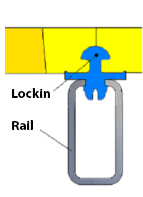The modular batten system was developed in the 1980s. The principle consists in forcibly inserting the various modules onto the chassis of the screen by previously inserting a batten, using a mallet, into the fixing rail slot.
 This is one of the most common solutions on the market.
This is one of the most common solutions on the market.
The method of fixing with battens is used to solidly position the panels. Firstly, one of the sides of the module having a groove is inserted into the batten, and then the second side of the module is forcibly slotted into the next batten using a mallet.
Dismantling in this case consists of inserting a screwdriver or other tool into the meshes of the module to create leverage and remove it from the batten. Care should be taken not to damage the mesh, if the panels are to be reused.
The assembly/dismantling operations of the MIG system are quite challenging for maintenance teams, many of whom prefer the MGI-type T-key mounting system which is easier and faster to implement.